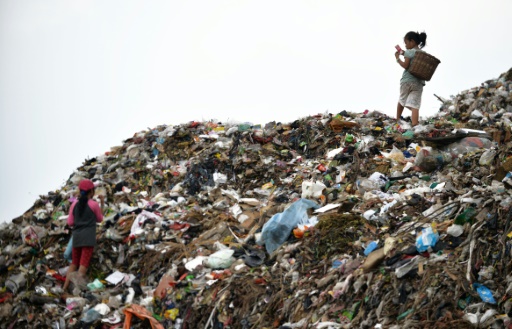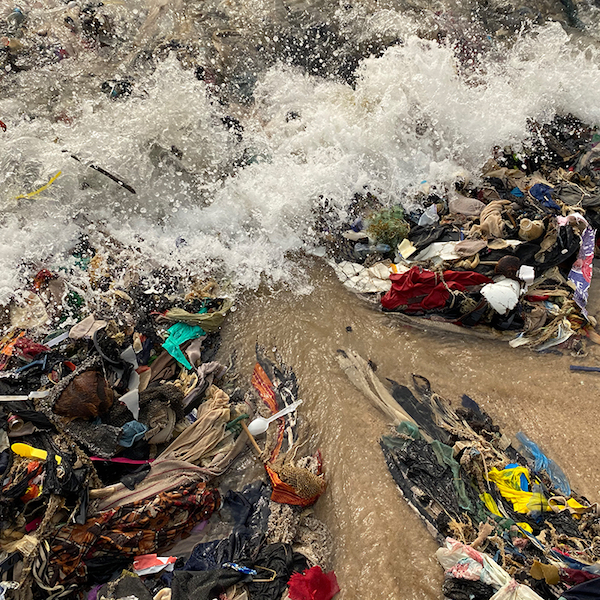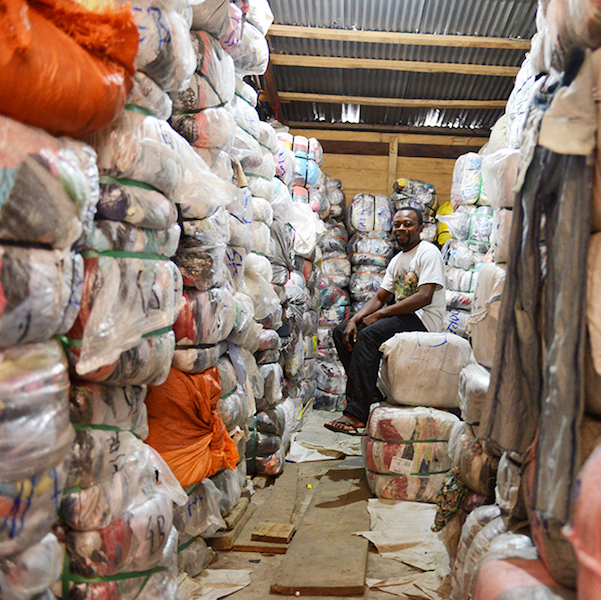
8th Iteration of Gathered Cloths modeled by Nik Evasco. Photo by Lisa Beth Anderson.
Gathered Cloths
How do you address the ever-growing global issue of textile waste?
More than 85% of textiles ever produced never get recycled, and 15% of textiles produced never reach the end consumer. Only 10-15% of gently used clothes and textiles donated to charity shops get sold.
Growth of textile waste in the US outpaces those of every other major category of waste. Worse yet, used textiles and clothes end up polluting cities and shores of less developed countries with lax environmental laws.
What will you do differently to enact positive change in this global issue?

8th Iteration of Gathered Cloths modeled by Nik Evasco. Photo by Lisa Beth Anderson.


Overview
Project Summary
Gathered Cloths is an ongoing textile project initiated during Climate Creative Spring 2021 cohort participation. It started with questioning the notion of “textile waste” in our daily life, especially in the Global North region. While we are surrounded with fabrics and cloths throughout our lifetime, there is a consistent disregard to real value of textiles and we tend to take them for granted.
Treated as mere commodities and easily disposable items, textile waste is one of the major problems of overconsumption and waste. How we treat textiles, our level of awareness of their lifecycle (from production to landfill), and complex sustainability issues – affecting garment workers, raw materials, and our planet – shape our perspectives of cloths. And for those who regularly create with textiles, how do we overcome the continuous struggle of repurposing or upcycling textile waste before they eventually end up becoming throw-away waste?
Inspiration
Manifestation of Gathered Cloths project is inspired by the state of second-hand textile waste mountain, clothes graveyard seen in countries like Indonesia and Ghana. Export of second-hand clothes from the Global North to less developed countries gradually makes this environmental hazard of continuous piling of unsold second-hand textiles in villages, towns, and cities that are supposed to be safe dwelling places for people to live and thrive.
Objectives
- to bring awareness to textile waste and overall textile lifecycle
- to progressively contemplate what it means to reuse, repurpose, and upcycle materials as a creative maker
- to encourage more discussions and actions to minimize daily household waste
Call to Collaborate
Being a solopreneur, there’s only so much I can create by myself. If you’d like to contribute finding more applications of Gathered Cloths and discovering new channels of discussions and community outreach, please contact me at musank@fafafoom.com.
Materials
Cotton and cotton blend fabric scraps and remnants that are gathered or rescued around the San Francisco Bay Area. A large portion from the initial batch for 1st and 2nd iterations are leftovers from Covid-19 initiative project. The rest are accumulated from my own stash as well as unwanted textiles gathered from neighbors and non-profit organizations.
The term “gathered” in Gathered Cloths refers to several terms:
- act of gathering unwanted fabrics / scraps / textile waste from the local community
- sewing technique commonly used to create ruffles in fabric manipulation
- practice of assembling many cloths together to create a bigger garment or object
Making Gathered Cloths
Strips of fabric are cut, gathered into ruffles, and sewed on a base cloth. Remnants that are too small are layered and stitched together to form ruched cloths. The results are gathered cloth pieces in various dimensions.
They are then assembled temporarily to create a bigger object, depending on how much area the assembled pieces can cover. Each temporary assembly involves creating one object from a collection of gathered cloth pieces.
At the end of each iteration, the gathered cloths are disassembled to their individual pieces. Every iteration starts and ends with a collection of ruffled cloths.
As more gathered cloth pieces are added, the overall logistic requirements for each iteration gets more complex over time. For the first few iterations, the gathered cloths are assembled to form a garment. However, now that there are more than 100 gathered cloths, there will be less constraint to adhere on a humanoid form. The cloths can be assembled to form a bigger non-garment piece – anything the assembler(s) can imagine.
The growing number of Gathered Cloths will gradually overwhelm both storage space and expand assembly possibilities. This will expand end-result possibilities and meaningful discussions around overconsumption, overproduction, and textile waste.

Iterations
Gathered Cloths Progress
Gathered Cloths is an ever-evolving textile project. Each iteration involves more scraps than the previous ones, and will get infinitely more complex as time goes. Click on each picture below to read more about each Gathered Cloths iteration process.
1st Iteration

2nd Iteration

3rd Iteration

4th Iteration

5th Iteration

6th Iteration

7th Iteration

8th Iteration

Community
Collaborations
Each Gathered Cloths iteration presents unique opportunity to reach out to a wider audience. From off-shoot projects to immersive web experience, this textile art project represents an ever-growing call to collaborate with creatives in various disciplines.
Climate Creative Showcase, San Francisco (2021)

Earth Day Community Celebration, Mill Valley (2022)

Climate Gallery Launch, San Francisco (2022)

Fashion Photoshoot with Cynthia Anderson, Albany (2022)

Artivism Exhibitions, Virtual Reality (since 2022)

the Body + the Land Project Launch, Albany (2023)

1st Iteration
Finished cloths: 7
Total Gathered Cloths: 7
On the first week, 7 gathered cloths are assembled to create an unfinished waist corset and a shoulder cover.
Throughout the week, the highlight is about taking time to create, not being concerned of ruffle non-uniformity, as well as creating a realistic timeline for stitching ruffles into base cloths. There are a couple techniques explored for making ruffle / ruche which makes sense for these first few gathered cloths.
They are relative small in size (see picture with grid backgound – a square is 1″ x 1″) for now, but the base cloth’s size will get continuously bigger as more gathered cloths are made.
Another consideration is limiting number of fabric patterns in one gathered cloth, and whether to concentrate certain colors on the fabric edge for easier assembly process.







2nd Iteration
Finished cloths: 8
Total Gathered Cloths: 15
On the second week, 8 gathered cloths are added to the pile. They are then assembled to create a mini dress with a trailing vertical strip.
As a more comfortable stride of making process is established, larger pieces of Gathered Cloths are made within the same time spent (roughly 10 hours) in the first week. I experiment with taping and ruching long thin strips of fabric onto a large rectangular base cloth. It ends up as a total failure, but a lesson learned regardless.
Color scheme clashing is no longer an obstacle. Instead, there’s a rule of thumb: pick the same or analogous color that is visible from the previous ruffle. If that’s not possible, then try picking fabric pattern that contrasts well.

Failed experiment using masking tapes for stabilizing large base cloth. | Gathered Cloths – Fafafoom Studio







3rd Iteration
Finished cloths: 6
Total Gathered Cloths: 21
On the third week, 6 gathered cloths are finished. The picture below shows four pieces that were finished first.
Total of 21 cloths are then assembled to create an asymmetrical coat.
This marks the first week of working with long rectangular base cloths. I acquire some deteriorating cotton table cloth with eyelet details. Divided into 3 sections of similar size (approximately 30” x 13” each), they become base cloth for most of the gathered cloths finished this week.
Due to the large size, I pin cloth strips onto the edge of base cloth before sewing them. While finishing a large gathered cloth take time (about 1 – 1.5 hour each), it’s more efficient since idle periods between pinning cloth strips and sewing are eliminated.


Assembling all gathered clothes this week produces an asymmetrical coat with an extended square-ish shape on the front left.





4th Iteration
Finished cloths: 15
Total Gathered Cloths: 37
On the super productive fourth week, 15 gathered cloths are finished. Four of them are large rectangular cloths, similarly sized as the ones introduced in the previous week. Moreover, one long narrow strip done on second week is cut in half.
Starting from this week, the Gathered Cloths assembly is somewhat stabilized to create variations of an outerwear garment that fits various bodies (instead of a size 6 professional dress form). With the adjusted number, a total of 37 cloths are assembled to create a long coat that grazes the floor.
However, this coat is mostly dissembled one day after assembly. The top part is more securely assembled using whip stitches in preparation of a public showcase a week later, and it’s basted in a way that can fit various body types.

In the process of whipstitching the “core” of torso, starting with back panels.


Inside view of the fourth week’s assembly. The coat is mostly dissembled one day after.








5th Iteration
Finished cloths: 7
Total Gathered Cloths: 44
On the fifth week, 7 gathered cloths are finished. All 44 pieces are ready for its first public showcase at Climate Creative Showcase on July 17th, 2021 at Golden Gate Park, San Francisco. They are assembled into a kimono-inspired coat with an extended train. See Logan Evasco, Qi Diaz, and Lisa Anderson wearing Gathered Cloths on the pictures below!








Logan wearing Gathered Cloths coat | Fafafoom Studio

Qi wearing Gathered Cloths coat | Fafafoom Studio

Lisa showing off the back of Gathered Cloths coat | Fafafoom Studio
Climate Creative Showcase
Gathered Cloths at Climate Creative Summer 2021 Showcase
The first ever public assembly and exhibition of Gathered Cloths happened in Golden Gate Park, San Francisco. 44 pieces of ruffled cloths are temporarily assembled and disassembled on-site to fit several Climate Creative Spring 2021 cohort members. During the showcase, an impromptu fashion show on a small hilly runway happens, where more than 5 people wearing and working Gathered Cloths coat in their own way.
Photos by Lisa Beth Anderson, Mira Musank.





6th Iteration
Finished cloths: 19
Total Gathered Cloths: 63
After the fifth week, Gathered Cloths project went into a hiatus throughout the rest of 2021, even though new pieces are being made as more remnants (and spare time) are available.
In Spring 2022, total of 19 new pieces of gathered cloths are added to the mix. All 63 pieces are then assembled into a draped cloak with hood.









Earth Day 2022
Gathered Cloths Offshoot Project: Earth Day 2022
48 mini pieces (8 pieces each in 6 colors) of Gathered Cloths are made to represent various representations of climate hazards. These climate hazard pieces become part of a climate-themed ball throwing game “Stop, Drop & Roll: Chasing Growth” by Al Grumet. The physical structures of the game setup also includes cardboard boxes covered in reclaimed textiles, courtesy of Tracey Kessler.
“Chasing Growth” was part of Earth Day 2022 celebration at Mill Valley Community Center on April 24, 2022.





7th Iteration
Finished cloths: 21
Total Gathered Cloths: 84
The 7th iteration involves the most complex process yet. The growing number of cloths make the assembly more time consuming and labor intensive. That said, I believe their growing presence makes insightful discussions around textile waste more likely. This tree-like, towering figure becomes more imposing when it’s digitized and sculpted into a 3D model.
The 3D model of Gathered Cloths’ 7th iteration is first unveiled in Climate Gallery’s inaugural VR exhibition “A Study in Artivism” in the Textile Arts Gallery.







Climate Gallery Launch
The Climate Gallery Launch Party in San Francisco, November 2022
One week before A Study in Artivism virtual exhibition opens, Climate Creative holds an in-person launch party in San Francisco. The event features project overview by The CLimate Gallery team and artists (David Solnit, Mira Musank), a preview of Climate Gallery’s five virtual galleries experienced with a VR headset, along with special dance performance by Nicky G. The sold-out event attracts climate-conscious individuals, many of them involved in 350 Bay Area organization.
Photos by Rachel Z.

Nicky G. performing with climate activism video and Gathered Cloths display on the background.

Logan Evasco addressing the audience during Climate Gallery Launch Party.

Mira Musank addressing the audience during Climate Gallery Launch Party.

Siobhan Keegan addressing the audience during Climate Gallery Launch Party.

David Solnit creates protest posters during Climate Gallery Launch Party.
Fashion Photoshoot with Cynthia Anderson
Fashion Photoshoot with Cynthia Anderson at Albany Bulb, Summer 2022
To curate my Textile Art Virtual Gallery for The Climate Gallery project, I invite 6 collaborators to create exclusive content. I’m grateful to have runway photographer Cynthia Anderson (her works are published in Vogue, Marie Claire, Elle, GQ, and many other international publications) do a fashion photoshoot with the 6th iteration of Gathered Cloths. On one summer day, we met at Albany Bulb and did a photoshoot for one hour. Her photos are featured on the main hall of my Textile Art Virtual Gallery.
Photos by Cynthia Anderson.

Gathered Cloths presentation at Mira Musank’s Textile Art Gallery, featuring photography works of Cynthia Anderson.

Mira Musank wrapped in 6th iteration of Gathered Cloths. Photo by Cynthia Anderson.

Close-up of Mira Musank wrapped in 6th iteration of Gathered Cloths. Photo by Cynthia Anderson.

Mira Musank wearing 6th Iteration of Gathered Cloths at The Albany Bulb. Photo by Cynthia Anderson.
Virtual Reality
Gathered Cloths in Virtual Reality
Gathered Cloths have found a new channel to showcase in virtual reality. Through the immersive experience of spatial computing, digital 3D models of Gathered Cloths’ 6th and 7th iterations, along with future iterations can be permanently showcased while their physical counterparts keep evolving. This extended presentation enables my expressions in artivism to reach global audience.
The virtual presentation of Gathered Cloths started in November 2022 with Climate Gallery. Using Mozilla Hubs platform, Mira’s Textile Art Gallery showcases Gathered Cloths’ 6th and 7th iteration 3D models in the Main Hall.
On February 2023, a mobile-friendly virtual presentation for the Kanda La Ziwa Festival in Kenya was built. This week-long festival is organized by NAAM Festival to promote #JusticeforLakeVictoria movement.
On April 2023, a virtual gallery showcasing works from Mira and Kimberly Kuniko of Lacelit was built. This gallery is a setting for a guided creative retreat, where participants respond to prompts presented in virtual reality setting to express their creativity in their own physical space.
On October 2023, a custom Gathered Cloths 3D object was featured in a virtual catacomb chamber during Mozilla Hubs’ Community Halloween 2023 celebration.
More virtual scenes are always in the works!


Main Hall of Mira Musank’s Textile Art Gallery – Climate Gallery

Gathered Lake – a mobile-friendly virtual presentation of Gathered Cloths

Birds-eye view of Gathered Lake virtual scene

Gathered Cloths Garden – a hall in togethering Gallery, a private virtual gallery for “Layered Stories” creative retreat.

Gathered Cloths featured in Mozilla Hubs Community Halloween 2023 Celebration
the Body + the Land Project Launch
Gathered Cloths Offshoot Project: “the Body + the Land” project launch
A temporary exhibition of Gathered Cloths joined the launch of Invisible International’s the Body + the Land project at The Albany Bulb on Saturday, May 6, 2023. The Body + the Land is a year-long community audio art project that gathers stories from Bay Area residents about the connection between health and the environment we are in.
More than half of 84 Gathered Cloths were wrapped and pinned on pieces of driftwoods or shaped into blankets for visitors to touch, observe, step on (for canines), or wrap around themselves with. The flash installation only lasted for a couple of hours.
Along with assortments of snacks, drinks, kites, and a white board to collect people’s stories, the Gathered Cloths installation invited people to have further discussions about textile waste, people’s creativity, and how we use textiles in rituals or as personal identifiers.





8th Iteration
Finished cloths: 16
Total Gathered Cloths: 100
The 8th iteration marks the first time some maintenance work is needed. 11 existing cloths are either repaired or reinforced with more ruffled strips. Considering the increasingly overwhelming total weight of the assembly, ruffles for all 16 new cloths are made with synthetic or synthetic blend fibers, sourced from a deconstructed rug from a San Francisco resident. The total weight of all 100 cloths comes close to 25 lbs.
The final assembly of the 8th iteration is unveiled during Hem & Jaleo showcase on October 21, 2023. Modeled by Nik Evasco, the 8th iteration of Gathered Cloths is featured during the figure drawing activity. Read more about Gathered Cloths feature in Hem & Jaleo showcase on Fafafoom Studio Newsletter’s September 2023 issue.
Photos by Lisa Beth Anderson, Mira Musank.






Nik Evasco wearing 8th iteration of Gathered Cloths during Hem & Jaleo showcase (Oakland, October 21, 2023).





